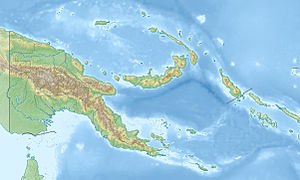Dakataua
| Dakataua | ||
|---|---|---|
| height | 400 m | |
| location | Papua New Guinea | |
| Coordinates | 5 ° 2 '39 " S , 150 ° 5' 53" E | |
|
|
||
| Type | Stratovolcano / Caldera | |
| Last eruption | 1895 ± 5 | |
| particularities | Crater lake | |
The currently inactive stratovolcano Dakataua marks the northern end point of the Willaumez Peninsula on the island of New Britain in Papua New Guinea, part of the Bismarck Archipelago in the Pacific Ocean . Just a little more than two and a half kilometers of flat terrain separate it from the 1,155 meter high, extinct volcano Bola (also called Wangore ), directly south .
The main feature of the Dakataua is its huge caldera (9.3 kilometers north-south and 11.8 kilometers west-east), which is filled by a large freshwater lake at least 120 meters deep . The caldera was formed around 800 ± 50 in the course of a very massive Plinian eruption , which can be classified with a value of 6 on the volcanic explosion index . About ten cubic kilometers of tephra were ejected - comparable to the eruption of the Pinatubo in 1991. Due to the sudden emptying of the magma chamber near the surface , the summit of the mountain collapsed under its own weight and formed today's extensive caldera. The Dakataua lost most of its original height; nowadays the edges of the crater only tower 400 meters. The lake surface is about 50 or 73 meters above sea level . A deposit of debris and debris found northeast of the Dakataua on the ocean floor could be an indication of a large rock fall or flank collapse before the caldera was formed.
At least five other eruptions in the course of the following centuries partially filled the caldera again and formed a headland growing from the south, which now almost divides the lake in half. Mainly responsible for this are the activities of the Andesite Mount Makalia , which rises 350 meters above the headland. The last eruptions to date at the Dakataua complex occurred around 1895 when three cinder and ash cones formed and a lava flow to the east occurred at Mount Makalia , which can still be seen today as a clear contrast in the otherwise dense vegetation. At the moment only solfataras are observed at the summit of Mount Makalia .
Web links
- Dakataua in the Global Volcanism Program of the Smithsonian Institution (English)
